The Gold Coast Light Rail, also known as G:Link opened in July 2014, making it Australia’s newest completed tram/light-rail line.
I was very impressed when I rode it last week. As you would hope and expect, they’ve put a lot of thought into the design, and there are a number of things Melbourne can learn from it.
The route
The line is 13 kilometres, from Broadbeach South, parallel to the beach, through the very busy, dense centre of Surfers Paradise, up to the Gold Coast University Hospital at the northern end.
While not ideal — it doesn’t serve the airport or connect to the rail line to Brisbane — they obviously built it with later extensions in mind, as both termini have additional currently unused track which is intended to be used should the line be extended.
There was opposition while the line was being built, but it now seems to have been deemed a success, with the project helping to spark billions of dollars of investment along its route.
An extension to Helensvale Railway Station got underway in 2016, expected to open before the Gold Coast hosts the Commonwealth Games in 2018.
Behind hoarding at the northern terminus you can see work is already underway.
Tram lanes
From what I saw, along almost all of the route the trams travel in their own dedicated lanes. This has resulted in closure of vehicle traffic lanes, and in some sections of Surfers Paradise Boulevard, means car traffic can only travel southbound. The nearby Gold Coast Highway caters for through-traffic.
This has turned Surfers Paradise Boulevard from something of a traffic sewer (as I recall it in 2011) into almost a transit mall, with a small amount of parking for southbound cars, but mostly they move slowly through seeking to access side streets and off-street parking.
I did see what I’m guessing was an Uber X car, doing a couple of laps trying to find their booked fare. At one point he stopped and a couple climbed in, only to get out again when it became apparent it was the wrong Uber.
There is a small section of shared roadway where cars and trams mix, northbound only between Thomas Drive and Cypress Avenue towards the northern end of Surfers Paradise — it appears this is to provide vehicle access to a few side streets.
Traffic light priority
What’s really eye-opening to a Melburnian is the traffic light priority for trams.
T lights are used extensively along the route. But unlike Melbourne, they don’t go green for trams unless trams are approaching. And when they do, they anticipate the tram’s arrival, triggering the T light to prevent the tram having to wait.
Yes, real traffic light priority. Not just reducing delays, but keeping the trams moving.
This video shows it in action.
Melbourne has almost nothing like this. The closest we have is the two former rail lines, 96 and 109, where trams approaching former rail level crossings get priority, sometimes even with boom gates.
But we have many, many other routes running in their own lanes/alignments that could benefit from this technology. At the very least, it should be implemented in places like St Kilda Road, Dandenong Road (subject to a trial in 2015 – what was the result?), Victoria Parade, Burwood Highway, Flemington Road, Royal Parade, Plenty Road…
And there should be no reason that approaching trams in mixed traffic can’t also be detected so they can get a green.
Gold Coast tram priority isn’t perfect. In the very densest part of Surfers Paradise I saw trams waiting at red lights. It wasn’t actually obvious why this was the case, as it appeared a tram green could have been inserted into the sequence without unduly disrupting other motor and pedestrian traffic.
The other issue is that sometimes the tram didn’t get the green soon enough, and had to slow down slightly. This is a noticeable issue on Melbourne’s 96 and 109 routes as well. Perhaps it’s to enforce a slower speed limit at possible conflict points with cars.
Tram stops and tram accessibility
Stop distances are far wider than most in Melbourne.
By my calculations there’s an average of about 850 metres per stop, though some in the dense area of Surfers Paradise are a bit more closely spaced.
All stops have platforms, and all trams are low-floor, meaning the entire route is accessible for mobility aids and prams — as you would hope for such a recently built system.
The trams
Possibly unique, inside the trams there are dedicated spots for surf boards, though I didn’t see any in use.
There is extensive use of ads covering the windows. Visibility from inside looking out seemed mostly okay on a clear day. But it may be quite a different story at night, especially when raining.
Announcements and screens indicating the next stop helps obviously, but it was difficult to see inside as the tram arrived to tell which section was least crowded.
Ticketing
Card readers are at stops, not on the trams. Of course this is possible where there is only a small number of stops — it would be difficult on a huge system of hundreds (thousands?) of stops, as in Melbourne.
Each platform has a ticket machine and information. I saw no platform staff (sometimes seen at busy Melbourne CBD stops) though it appeared common for the stops to have small retail (eg coffee shops) built-in.
The tickets are part of the Go Card system, offering smartcards or short term (single trip) tickets.
Other than drivers, there are few staff on the system. I did see what appeared to be the equivalent of Melbourne’s Authorised Officers, groups of two or more uniformed staff roaming around, it appeared with ticket checking equipment, but I didn’t see them checking tickets.
Some trams included advertising nagging people to pay their fare – as with Melbourne, the system is open, but they sometimes have ticket checking blitzes.
Interchange
When you ask Google Maps to plot you a trip from Gold Coast Airport to Surfers Paradise, it tells you to hop aboard the 777 bus (which runs every 15 minutes, 7 days-a-week, which I think might make it a better level of service than just about any single Melbourne bus route, though some combined services would surpass it).
Then it tells you to alight the bus and walk ten metres and board a tram the rest of the way.
Frankly I didn’t believe it. Ten metres? They’re making it up.
But when you step off the bus, you see it’s true. The Broadbeach South interchange is really nicely setup – buses arrive either side of the tram, which is on its terminating track in the middle of platforms on either side.
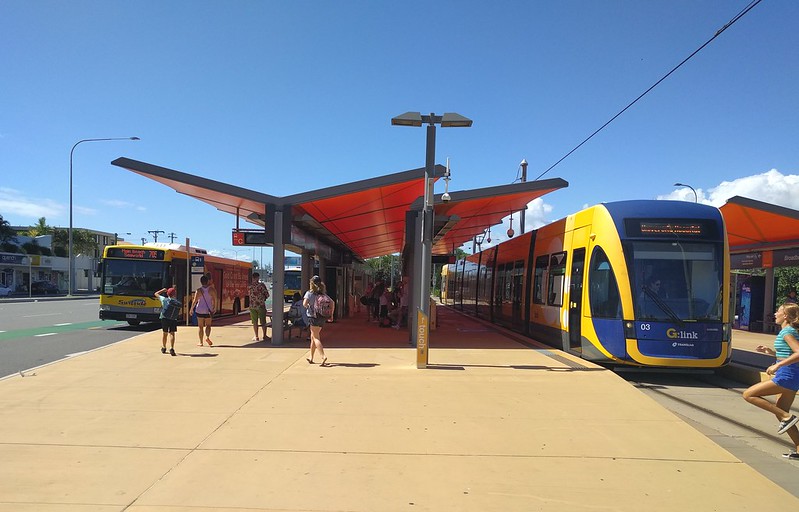
(Apologies, I have broken my own rule here and neglected to get a good photo with a camera that properly captures the LED displays.)
When the light rail line opened, local bus routes got a shake-up. This makes sense – with a new 13 km trunk route, it’s logical to change bus routes around to feed into it rather than parallel it, though a few routes still make the north-south route parallel to the trams.
Quite obviously the designers have given some thought as to how to make interchange, particularly at Broadbeach South, as easy as possible. Other connecting services weren’t quite as good, but still — I don’t think we have anything this good in Melbourne. (There is a tram/bus interchange at Queensbridge Street outside the Casino, but it’s in a location which is unlikely to see many passengers changing between those services.)
The interchange includes bicycle parking, and there are shops nearby, though no retail directly integrated into the stop.
Timetable
And how often to the trams run?
Well the “timetable” (which is actually a frequency guide) sums it up: every 7.5 minutes on weekdays, 10 on weekends, 15 evenings and early mornings, and 30 overnight on weekends.
On weekdays overnight, the 24/7 700 bus, which normally connects with the tram at Broadbeach South, is extended to parallel the tram route, running every half-hour on weekdays overnight.
This means this line runs a better off-peak, evening and overnight service than almost any Melbourne tram route, though we have more frequent peak services on some routes.
Specific times aren’t published at stops, nor on paper timetables — the stops have realtime departure countdowns, and the paper timetables only have the frequencies. This is probably almost okay when the trams are every 10 minutes or better… less so when only every 15 or 30 minutes.
The Translink web site (and it appears Google Maps/Transit) includes specific times.
Lessons for Melbourne
The trams in Melbourne and on the Gold Coast are operated by the same company, Keolis DownerEDI Rail (KDR).
Gold Coast’s single line opened only in 2014, and is built to modern standards. Melbourne’s tram system is vast, and aging. We can’t expect our network to be brought up to these standards overnight.
But we can learn a lot from the Gold Coast.
More frequent services at all times would cut waiting times and make trams more attactive to passengers.
The opening of the line helped boost Gold Coast public transport overall by some 22% in the first ten months. Improving Melbourne’s tram connections (such as ensuring trams don’t terminate just short of railway stations) would help the whole public transport network to grow.
Tram priority is something holding Melbourne’s trams back — and is an important part of the Gold Coast system. Putting in some proper traffic light priority to prevent trams having to wait at traffic lights would be almost imperceptable to Melbourne’s inner-city motorists, but help ensure tram travel is more time-competitive and that our huge investment in tram infrastructure is more efficiently used.
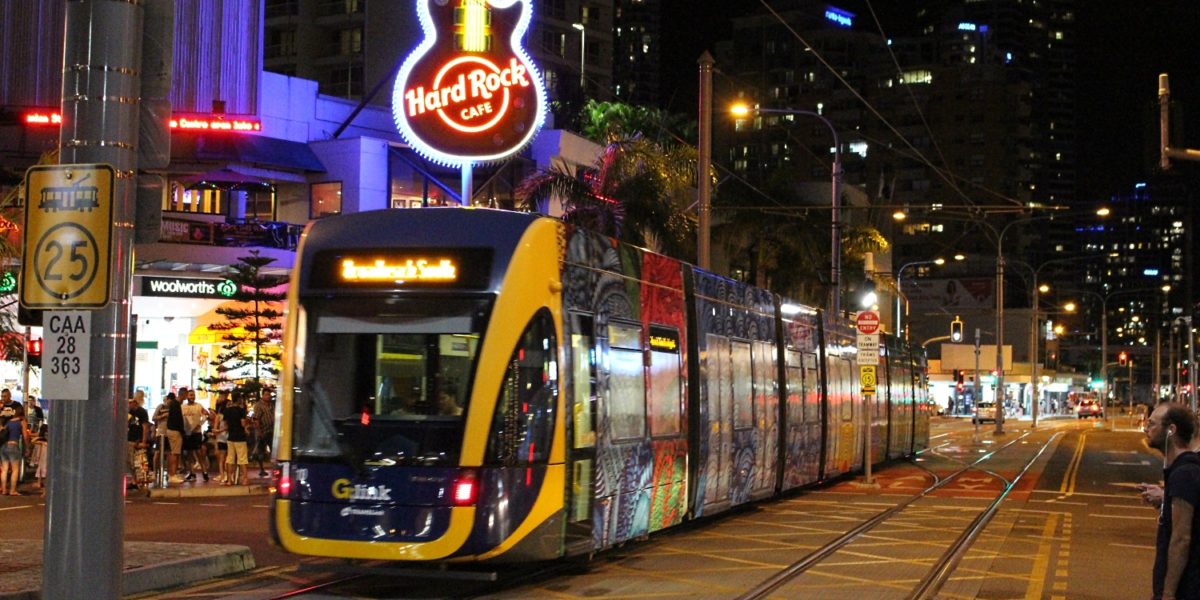

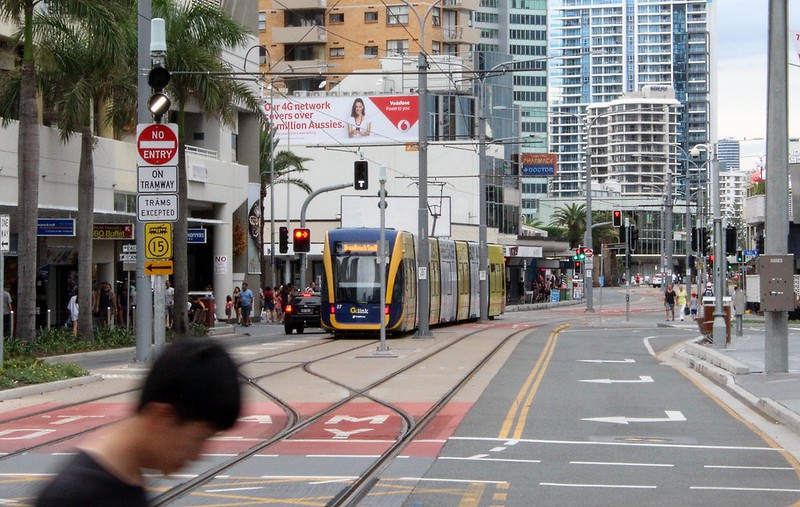
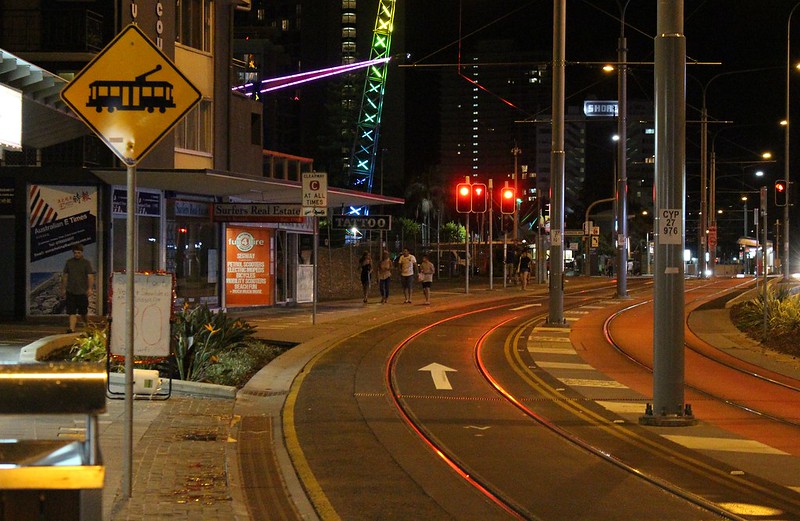
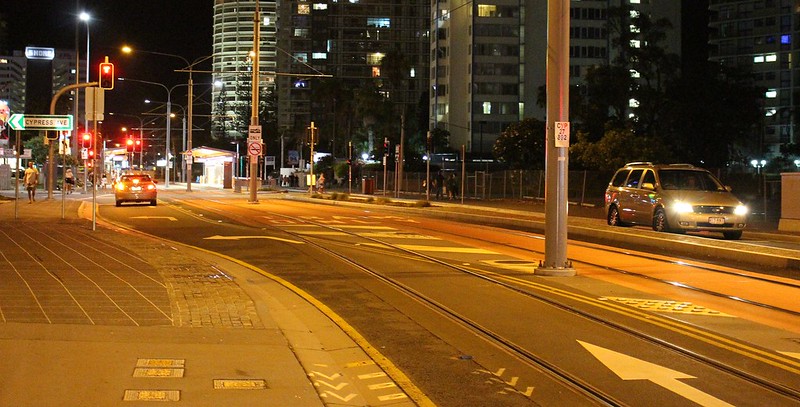
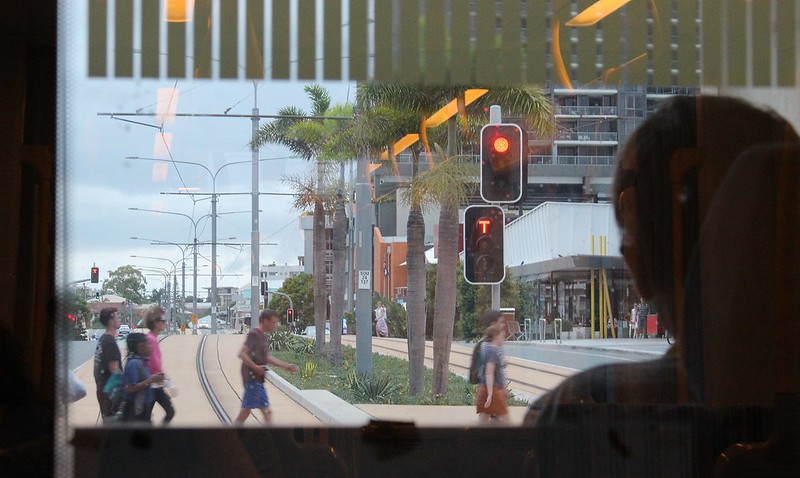

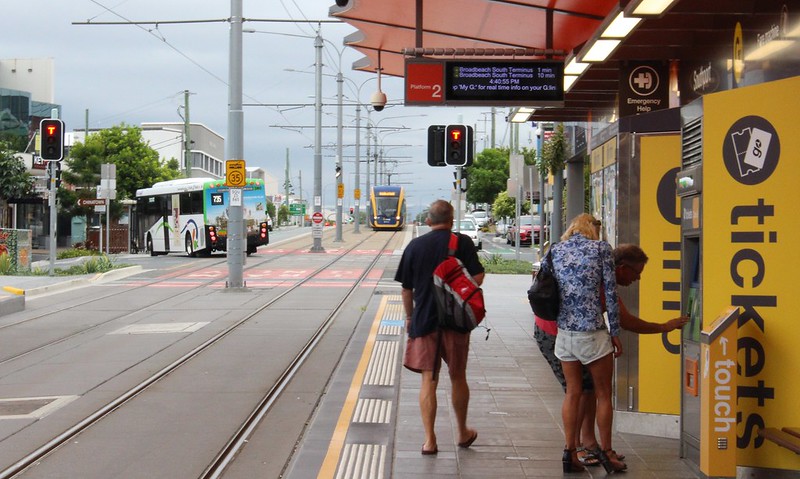


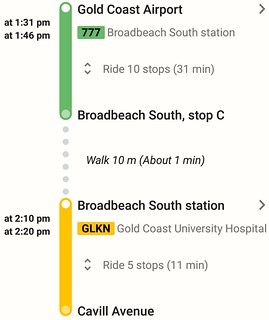
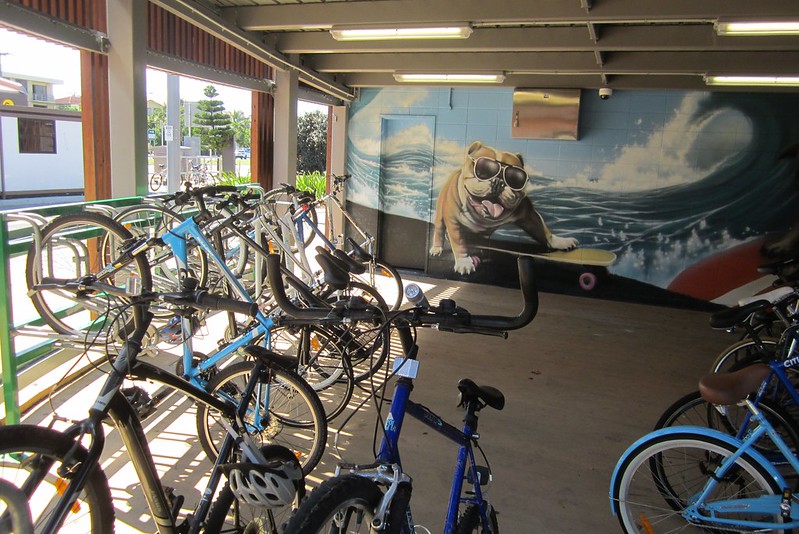
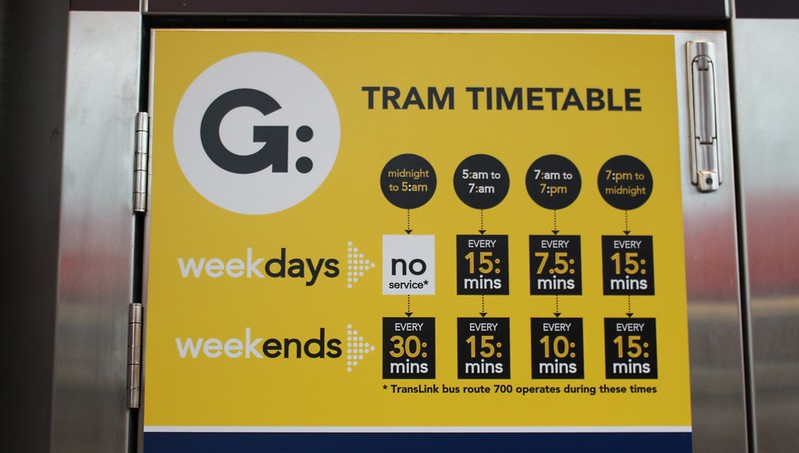
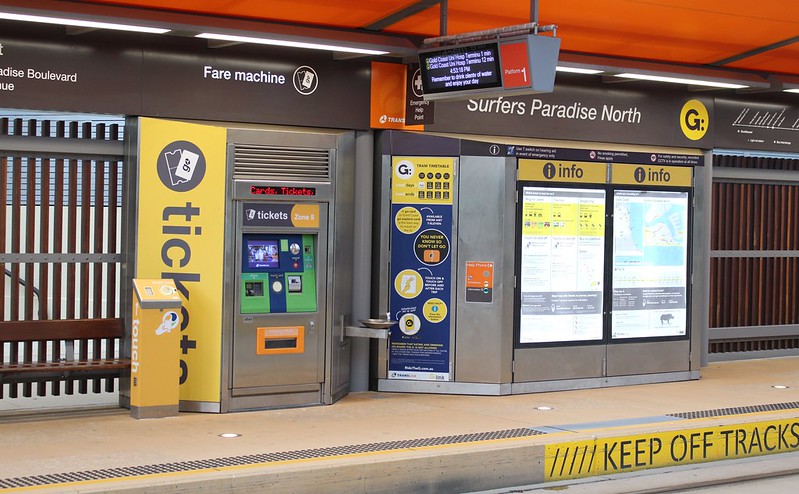
20 replies on “Gold Coast Light Rail: tram priority far better than anything in Melbourne”
Melbourne’s trams run in Priority C (i.e. no priority like a bus) right of way.
Gold Coast trams run in Priority B right of way (i.e. separated lanes, only crossings are shared with cars).
Melbourne can speed up its tram services by going through the entire network and deleting stops so that most stops are about 800m apart in the suburbs, 400 m or so on approaches to the CBD and perhaps 200 m within the CBD grid.
The entire bus network needs to be radically reorganised, get someone in like Jarrett Walker and associates to reduce and simplify the network dramatically.
Focus on improving the current system before thinking about extensions to new areas.
Hi Daniel, always enjoy reading your thoughts on these matters. You mention at one point tram extensions to train stations – can you make a quick fire list here of where these are feasible in Melbourne?
Sir Joh was the one who tore up all the rail in the 70s wasn’t he? Is costing hundreds of millions to replace it. The other cities never should have gotten rid of their trams in the first place since they are trying to put them back now for $$$$.
@NTW, short extensions to more logical termini would help the tram system by making the suburban outer ends of routes more viable.
@Paul, on this page is one list: http://www.ptua.org.au/policy/network/
@Tim, no. Joh Bjelke-Petersen was Premier from 1968 to 1987. He was in charge when Queensland Rail modernised and electrified the Brisbane network in the 70s and 80s.
The last trams ran in Brisbane in 1969 – I’m not sure if Joh influenced that; I gather it was primarily Brisbane Lord Mayor Clem Jones.
@Daniel, I am not denying that short extensions to more logical termini would help the tram system. But that requires construction and money (~50 million/km).
Removing stops can be completed very quickly, possibly within 12 months. That would speed up the entire network, not just lines that stop short of train station. A similar thing could be applied to bus stops as well to speed them up.
Tram extensions are a good idea, but that is a longer term project that will take more time as it requires significant funding behind it, and possibly the purchase of more trams (longer distance – more trams required for the line).
The post I wrote last year, but of course you did it so much better. I don’t recall any delays at all at traffic lights for G Link travel. VicRoads control our most of our tram system’s traffic lights and while at times they will do what they are told by the Minister and improve tram travel, they essentially focus on roads and moving traffic. We have heard so many noises over the years about Vic Roads improving tram travel time, but what has come of it? It altered the traffic lights at St Kilda Junction so that a 16 St Kilda tram can not get through on the same set of lights that a leading 3 or 67 can. Route 16 used to be able to do that. Tram priority T lights were installed at Commercial Road and Chapel Street, and Toorak Road and Punt Roads Years ago but never activated. Just last year tram priority lights were installed at Dandenong Road and Glenferrie Road, but not activated.
I would have thought the removal of the railway crossing at Gardiner would have sped trams up. Instead it has attracted traffic, trams are extremely delayed in the evening peak by a build up of east bound traffic in Malvern Road, and tram priority to cross the underground train line and freeway much reduced or non existent. How great it is to see north bound cars flowing through while the tram has to just sit there.
Vic Roads plays with the traffic lights at Toorak and Glenferrie Road, but for a decade they have never worked well for trams.
Former tram priority has been lost in Dandenong Road, but will Vic Roads fix it? No.
The last outrageous change to traffic lights at the corners of Franklin, Victoria and Swanston Street has trams much disadvantaged. The traffic lights sequence that seemed to be designed to move trams along quickly has now been adjusted to to cater for motorists inconvenienced by the Franklin Street road closures. North bound trams now sit for a full set of traffic light at Franklin Street, then move on to Victoria Street where they will sit for another full set of traffic lights. We are talking about 1 to 2 minutes delay. South bound is not ideal either, but not as bad.
Vic Roads has the capacity for improving tram movement to the standard of the Gold Coast, but they won’t do it until there is a specific order and grant of funds. Over the years you must have hear heard the government propaganda about speeding up trams from both sides of government, yet it has not happened. Meanwhile, our trams move ever more slowly, apparently the slowest in the world.
Doubt we will see proper bus-tram interchanges in Melbourne anytime soon seeing that buses seem to play second fiddle to Melbourne’s trams. Even bus-train interchanges work better here.
The buses in SE Queensland have had to ply main trunk routes there so the passengers aren’t often dumped far from interchanges (though not always). It seems only in Doncaster (and on the other smart buses) are the bus passengers given proper treatment.
Sometimes I feel sorry for the disabled and elderly passengers having to change means of transport. The bus interchange from my local train station requires a good 5 minutes walk for an able bodied person like me, and it requires me to navigate through a station car park, or, if I want to stay away from traffic, walk further out on the main road pavement to reach the bus interchange.
Daniel, did you also notice how the trams accelerate and brake much more smoothly than our E Class, even though they are made by the same manufacturer? That jerk on take off that the E Class excel at simply isn’t there on the GC trams.
Regarding the advertising on the trams, GC mayor Tom Tate a few years ago said he wanted them removed to keep the appearance clean, but not sure what happened after that…
Also the G: link has an app that has a live map showing where the frams are, that would be your best option when travelling during the 30min frequency times!
A very comprehensive summary, thanks.
Sounds like cars don’t get held up behind a tram (think Burke Road). Is that the case with GC tram line?
@Steve, noted! I found real-time departure info on the G:Link web site, but didn’t look at the app.
@Roger, depends on your perspective. Every time I’ve caught a tram along Burke Road, it’s been held up by cars. When I’ve driven, I’ve been held up by other cars…
But in answer to your question, as mentioned in the post, almost all of the GC light rail is in its own dedicated lanes, apart from a short section (not used by much traffic) in Surfers Paradise.
“VicRoads control our most of our tram system’s traffic lights and while at times they will do what they are told by the Minister and improve tram travel, they essentially focus on roads”
Correct.
What’s happening with the incipient organisation ‘Transport for Victoria’? I haven’t heard anything of it for months.
Tram to bus interchange – this one at Vermont South is pretty good, albeit a poor mans version of the Gold Coast example
https://www.google.com.au/maps/@-37.8563549,145.1821304,3a,75y,145.85h,75.25t/data=!3m6!1e1!3m4!1scnb0T5qKNDfd_pnaxOtObA!2e0!7i13312!8i6656?hl=en
Tram Priority: many of Melbourne’s 1700+ tram stops are on the approach side of intersections/traffic lights. Therefore, even if the tram were to trigger the lights it would most likely, esp in denser area’s, need to stop to drop/pick-up passengers. This would result in holding the cross road at red for an unnecessary amount of time (until the tram departed through the intersection), or the tram signal going red whilst still alighting passengers (how frustrating). The picture of the tram and the Hard Rock Cafe somewhat illustrates this (was the tram moving in that picture, or still stopped waiting for pax?; the white T signal is apparent).
Nicholson St is classic (notorious) for this. Separated from traffic, but has to stop at white T signals because of stop location. https://www.google.com.au/maps/@-37.792557,144.9758798,3a,75y,203.34h,72.15t/data=!3m6!1e1!3m4!1siLpOLGjr_3KmU47OPunBWA!2e0!7i13312!8i6656!6m1!1e1
This is better design (on the same route): https://www.google.com.au/maps/@-37.7976447,144.9750945,3a,75y,234.94h,73.18t/data=!3m6!1e1!3m4!1sFpsWSzzKZGPf6VatxWKcgg!2e0!7i13312!8i6656!6m1!1e1
@Adam – the problem is that -without- light priority, those stops that have been moved to departure side are currently stopping at the lights, then *again* at the stop.
Admittedly that’s an implementation issue, but if priority couldn’t have been introduced at the departure-side stops, what hope is there elsewhere? (other than European cities doing it perfectly)
@ Dave – Agree completely.
There ARE intersections that could benefit by T signal priority right now – departure side (my 2nd e.g @ Nicholson and Johnston would benefit).
But many are on the approach side. Therefore, to get maximum benefit from T signal priority the stop would have to move.
The flavour these days is to ‘island’ the platforms, which I do like. The solution is to have T-priority and island in harmony = move the island away from the intersection. Not always ideal (connections etc), but would be amenable to priority signalling.
I have faith (??) that PTV and VicRoads understand this given the (future) 96 line upgrades: the intersection in e.g 1 above will be converted to platform and ~90m from the intersection with Ax. Parade – enough metres to put a sensor as the tram heads south after picking-up/dropping pax. And of course sensors for trams heading north before the intersection.
https://static.ptv.vic.gov.au/siteassets/PTV/PTV%20docs/Route-96-Project/Supporting-technical-documents/PTVH0559_Route_96_A3_Maps_STOP17.pdf
Would be great for those on holidays to be to get the tram at Coolangatta Air Port. My wife and I stay at Broadbeach when on holidays from Melbourne, and upon arrival at the airport, we need to catch a bus. If or when it does go to the airport, it would go through Mermaid Beach, which is also a great place to visit whilst on holidays. One final point I wish to make is that at Broadbeach there is the Pacific Fair shopping centre, its just had a $50-$60 million dollar face lift.
The reason as to why this light rail was built, is the Commonwealth Games are coming in 2018, and those coming are going to have a fantastic time.
[…] contrast, the Gold Coast Light Rail, which does have pretty good (not perfect) traffic light priority, but also shares some sections of its route with cars, and travels at low speed through heavily […]
[…] tram 75 to the centre, and upgrading the Burwood Highway section to proper light rail with Gold Coast-style traffic light priority would help a […]